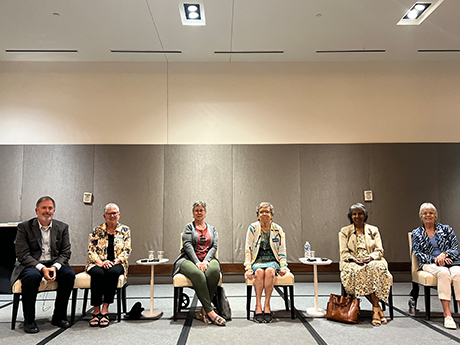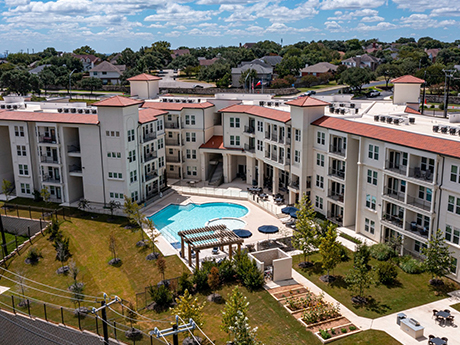DALLAS — Aging is something that happens to all of us physically, but according to some residents at active adult communities in the Dallas-Fort Worth (DFW) area, the psychological and emotional difficulties of growing older are easier to bear in the company of others.
Operators of this asset class are making this possible by delivering products and services that reflect the name “active adult.” Shared fitness classes, walking groups, book clubs, card games, communal gardening and organized shopping trips are but a few of the ways in which active adult owner-operators keep their residents’ bodies and minds fit and sharp.
Happy hours, dance parties and holiday shindigs — all taking place in an environment devoid of children — ensure that residents have very grown-up ways of relaxing and having fun.
The average age of a resident in an active adult community is 72 to 74, according to research conducted by the National Investment Center for Seniors Housing & Care.
The growth of active adult properties, which tend to be age-restricted hybrids of traditional multifamily and independent living product, is often linked to convenience for older households whose children have left the home. The prospect of having a smaller space without the various repair and maintenance tasks that come with owning a single-family home appeals to many older members of the population. While those aspects remain important, as the asset class matures, owner-operators of active adult communities are also realizing that culture, amenities and events are equally powerful marketing tools.
And who better to speak to those features than current residents? At the InterFace Active Adult conference, held May 4 at the Westin Galleria Dallas, attendees were treated to exactly that via a closing panel of local active adult residents who shared what their lives have been like since moving in. Seniors Housing Business and the InterFace Conference Group, both of which are divisions of Atlanta-based France Media, hosted the third-annual event, which attracted 363 industry professionals.
The five residents, some of whom asked that their last names be withheld, were all women living at one of several metroplex properties that are managed by Capstone Real Estate. They included Colleen Brandt, a three-year resident at Presidium at Edgestone in Frisco; Leisha Richards and Carolyn Quillen, both of whom reside at Alders Rockwall; and Harriet and Sandi, a retired educator and accountant, respectively, who live at Artistry @ Craig Ranch in McKinney. All these properties are reserved for renters age 62 and above.
Bryon Cohron, vice president of market analysis and business development at Mississippi-based market research firm ProMatura Group, moderated the discussion.
Physical appeal
After sharing the individual anecdotes that brought them to their current homes, the panelists detailed the physical amenities that they value most.
In keeping with the broader appeal of active adult, these features and attributes included numerous outdoor gathering and activity spaces, outsourcing of maintenance and repairs and general walkability to nearby shops and restaurants.
“The ease of being able to travel without worrying about keeping up a house and yard while you’re away is something I’ve come to value,” said Leisha. “You don’t have to worry about watering plants or something breaking while you’re gone, which I think is a big selling point for prospective residents — just giving up that stress of owning a home.”
Outdoor spaces and activities were of particular importance to some panelists, including Sandi, an avid gardener.
“At The Artistry, we have a big, covered arbor area with seating all around, and when the weather is good, that’s where you gather outside,” she said. “It’s a great place to bring grandkids and friends because it’s basically like your own giant patio.”
Multiple women also expressed gratitude for the variety of common spaces — both small and large — at their properties that were conducive to hosting events or entertaining guests. The ability to carry that aspect of single-family homelife over to active adult residency was instrumental in easing the transition for many of the panelists.
“We have six kids and eight grandkids, and we were used to hosting the family gatherings with their significant others and friends,” Sandi said. “When we moved out, we worried about that, but the big open areas at the property haven’t hindered our ability to do that.”
“Having an outside, private patio area like we have at The Artistry is very important, but there are also alcoves throughout the building that allow you to meet with people,” said Harriet. She added that while she was impressed with certain aspects of the community’s great room, she also felt that its design would have benefitted from a more centralized location within the building.
Within their units, panelists expressed appreciation for spaces that could accommodate the storage of a considerable amount of possessions they’d accumulated over decades of homeownership.
“I have a lot of storage spaces, including a coat closet, which most one-bedroom units don’t have, as well as a laundry area and a pantry in the kitchen,” said Leisha. “And that’s a big thing I was looking for.”
The panelists said they all felt some apprehension about how they’d store their belongings in a significantly smaller residence. One expressed gratitude to a local realtor who works with senior living communities to facilitate garage sales for incoming residents, plus assist with the actual moving process for those persons who need it. Having help with the actual logistics of transitioning from a single-family home to an active adult community can be a big relief for some seniors, especially those who are older and/or widowed, the panel agreed.

To close the third-annual InterFace Active Adult conference, five women who reside at various communities in the DFW area shared their thoughts on what the experience has been like for them.
Mental, emotional responses
From there, the women discussed how living in their active adult communities made them feel as they navigated their later years.
The feedback provided reflected a consensus that while not perfect, the atmosphere of being around people of similar ages and stations in life — as well as the process of developing bonds with them — had been a pleasant surprise in transitioning into life as an active adult renter. This portion of the dialogue included a discussion on panelists’ perceptions of how active adult differs from independent living within the continuum of care of seniors housing.
“To me, ‘active adult’ says you’re going to be active, whereas independent living tells me you’re going to live on your own, not as part of a family community because you’re independent,” said Leisha. “There might be meals or more care involved than in an active adult community.”
Colleen stated that to her, the inclusion of and emphasis on having meals and care provided felt more like assisted living. “What we have is independent active adults,” she said, sparking murmurs of consent from other panelists.
“The Artistry at Craig Ranch had lots of activities to offer that made me realize I could live independently and actively,” said Harriet, adding that she was turned off when touring other properties that didn’t put forth that vibe. “Between the exercise classes that are offered and the independence of being able to use walking trails, it’s very attractive to senior citizens.”
Sandy echoed the importance of having a variety of fitness and wellness options on hand — water aerobics, yoga, massage therapy, manicure/pedicure service — all of which can be activities that bring people together. “One of the most important things to me is the camaraderie that develops there,” she said.
“When I lived in a single-family home, I’d walk outside, and there was nobody out and around,” Sandy continued. “Now, I can go out and always find somebody to chit-chat with have a card game, and that’s extremely important. We’re also all extremely supportive of each other whenever anyone is ill or loses someone.”
Carolyn expressed appreciation for the autonomy of active adult life. “We have a calendar of events for every month, and it’s as simple as doing what you want and skipping what you don’t want. They’re suggestions, but ultimately you decide how your day goes.”
The panelists acknowledged that some residents prefer to keep to themselves rather than become heavily immersed in group activities. But those who do enjoy the social engagement are especially appreciative of the programmed, organized events that facilitate the process of making friends and building bonds with neighbors.
“It’s not everybody that can afford active adult, and not everybody likes it,” said Carolyn. “We have one friend who recently moved out because she just wants her house back. So it’s a question of what works for you.”
“We have some folks who move in, and we never see them,” said Colleen. “But in talking with some of them when they are around, they say that they really like the security and the fact that it’s an all-adult community. They don’t have the noise of kids playing sports or running through the streets when they’re driving. So you have both sides — those that love the activities and want the community aspects, and those that aren’t as social themselves but still enjoy being around other adults in a secure environment.”
Those residents who do want to take full advantage of what their active adult community has to offer tend to be satisfied.
“When you visit these communities, they speak for themselves in terms of how people live and the activities they have,” said Sandi. “We’re not just living in our apartments wishing we had more to do. There’s a lot to do.”
Carolyn also touched on the pleasantly surprising human interaction that active adult living can offer “When you move in, you have no idea how wonderful the relationships you’re going to build will become,” she said. “We hear so much about how as we age, it’s so important to maintain relationships and keep your mind active. And after we saw during the pandemic what it’s like to not be able to do that, it’s even more vital to be able to build these friendships that can take you through bad times. And what you realize is that aging doesn’t have to be a bad deal.”
— Taylor Williams

